gucci 古奇介绍
- 格式:doc
- 大小:1.06 MB
- 文档页数:10
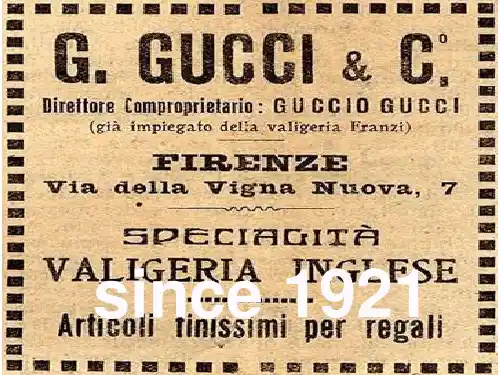
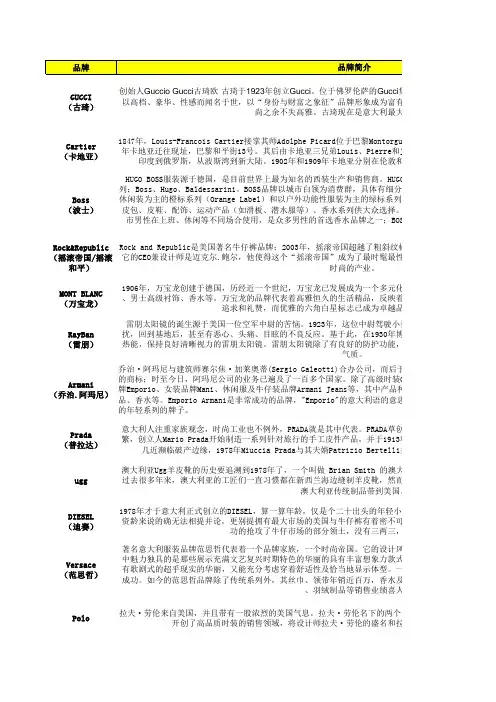
GUCCI (古琦)创始人Guccio Gucci古琦欧·古琦于1923年创立Gucci。
位于佛罗伦萨的Gucci集团是当今意大利最大时装向以高档、豪华、性感而闻名于世,以“身份与财富之象征”品牌形象成为富有的上流社会的消费宠儿时尚之余不失高雅。
古琦现在是意大利最大的时装集团。
Boss (波士)HUGO BOSS服装源于德国,是目前世界上最为知名的西装生产和销售商。
HUGO B列:Boss、Hugo、Baldessarini。
BOSS品牌以城市白领为消费群,具体有细分为以正装为主的黑标系列动休闲装为主的橙标系列(Orange Label)和以户外功能性服装为主的绿标系列(Green Label)。
除服男女皮包、皮鞋、配饰、运动产品(如滑板、潜水服等)、香水系列供大众选择。
BOSS的男士香水系列合都市男性在上班、休闲等不同场合使用,是众多男性的首选香水品牌之一;BOSS的女性香水则是年轻。
Cartier (卡地亚)1847年,Louis-Francois Cartier接掌其师Adolphe Picard位于巴黎Montorgu1899年卡地亚迁往现址,巴黎和平街13号。
其后由卡地亚三兄弟Louis、Pierre和Jacques继承家业。
他地,从印度到俄罗斯,从波斯湾到新大陆。
1902年和1909年卡地亚分别在伦敦和纽约成立分公司,从此MONT BLANC (万宝龙)1906年,万宝龙创建于德国,历经近一个世纪,万宝龙已发展成为一个多元化的、男士高级衬饰、香水等。
万宝龙的品牌代表着高雅恒久的生活精品,反映着今日社会对文化、质素、追求和礼赞,而优雅的六角白星标志已成为卓越品质与完美工艺的代表。
Rock&Republic (摇滚帝国/摇滚和平)Rock and Republic是美国著名牛仔裤品牌;2003年,摇滚帝国超越了粗斜纹棉。
它的CEO兼设计师是迈克尔.鲍尔,他使得这个“摇滚帝国”成为了最时髦最性感的代言人,并且摇滚个时尚的产业。
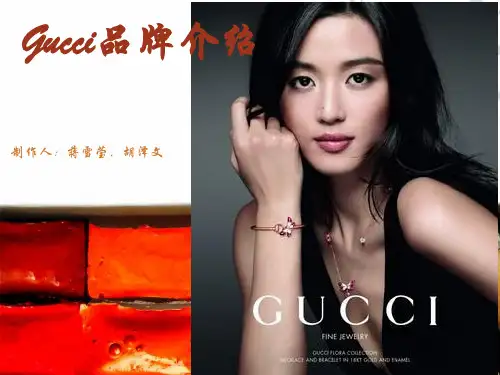
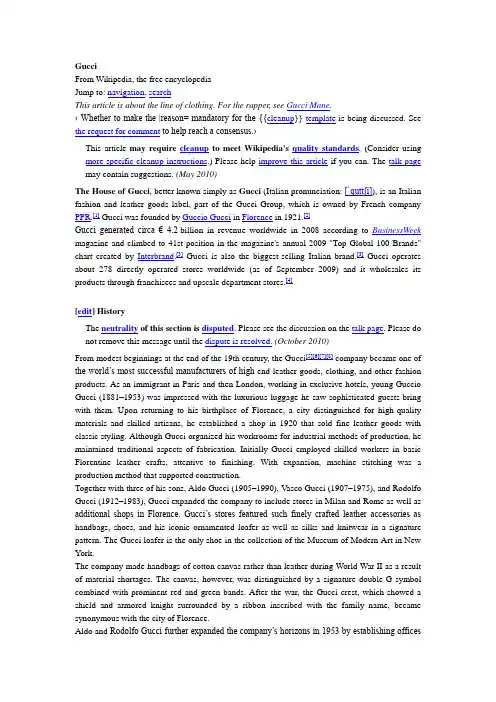
GucciFrom Wikipedia, the free encyclopediaJump to: navigation, searchThis article is about the line of clothing. For the rapper, see Gucci Mane.‹ Whether to make the |reason= mandatory for the {{cleanup}} template is being discussed. See the request for comment to help reach a consensus.›This article may require cleanup to meet Wikipedia's quality standards. (Consider using more specific cleanup instructions.) Please help improve this article if you can. The talk page may contain suggestions. (May 2010)The House of Gucci, better known simply as Gucci(Italian pronunciation: [ˈɡuttʃi]), is an Italian fashion and leather goods label, part of the Gucci Group, which is owned by French company PPR.[1] Gucci was founded by Guccio Gucci in Florence in 1921.[2]Gucci generated circa € 4.2 billion in revenue worldwide in 2008 according to BusinessWeek magazine and climbed to 41st position in the magazine's annual 2009 "Top Global 100 Brands" chart created by Interbrand.[3]Gucci is also the biggest-selling Italian brand.[3]Gucci operates about 278 directly operated stores worldwide (as of September 2009) and it wholesales its products through franchisees and upscale department stores.[4][edit] HistoryThe neutrality of this section is disputed. Please see the discussion on the talk page. Please do not remove this message until the dispute is resolved.(October 2010)From modest beginnings at the end of the 19th century, the Gucci[5][6][7][8] company became one of the world’s most successful manufacturers of high-end leather goods, clothing, and other fashion products. As an immigrant in Paris and then London, working in exclusive hotels, young Guccio Gucci (1881–1953) was impressed with the luxurious luggage he saw sophisticated guests bring with them. Upon returning to his birthplace of Florence, a city distinguished for high-quality materials and skilled artisans, he established a shop in 1920 that sold fine leather goods with classic styling. Although Gucci organized his workrooms for industrial methods of production, he maintained traditional aspects of fabrication. Initially Gucci employed skilled workers in basic Florentine leather crafts, attentive to finishing. With expansion, machine stitching was a production method that supported construction.Together with three of his sons, Aldo Gucci (1905–1990), Vasco Gucci (1907–1975), and Rodolfo Gucci (1912–1983), Gucci expanded the company to include stores in Milan and Rome as well as additional shops in Florence. Gucci’s stores featured such finely crafted leather accessories as handbags, shoes, and his iconic ornamented loafer as well as silks and knitwear in a signature pattern. The Gucci loafer is the only shoe in the collection of the Museum of Modern Art in New York.The company made handbags of cotton canvas rather than leather during World War II as a result of material shortages. The canvas, however, was distinguished by a signature double-G symbol combined with prominent red and green bands. After the war, the Gucci crest, which showed a shield and armored knight surrounded by a ribbon inscribed with the family name, became synonymous with the city of Florence.Aldo and Rodolfo Gucci further expanded the company’s horizons in 1953 by establishing officesin New York City. Film stars and jet-set travelers to Italy during the 1950s and 1960s brought their glamour to Florence, turning Gucci’s merchandise into international status symbols. Movie stars posed in Gucci’s clothing, accessories, and footwear for lifestyle magazines around the world, contributing to the company’s growing reputation.Gucci shop on Strøget in Copenhagen, DenmarkGucci’s distinctive lines made its products among the most frequently copied in the world in the early 2000s. Pigskin, calf, and imported exotic animal skins were subjected to various methods of fabrication. Waterproof canvas and satin were used for evening bags. Bamboo was first used to make handbag handles by a process of heating and molding in 1947, and purses made with a shoulder strap and snaffle-bit decoration were introduced in 1960. In 1964 Gucci’s lush butterfly pattern was custom-created for silk foulards, followed by equally luxuriant floral patterns. The original Gucci loafer was updated by a distinctive snaffle-bit ornament in 1966, while the ―Rolls-Royce‖ luggage set was introduced in 1970. Watches, jewelry, ti es, and eyewear were then added to the company’s product lines. A particularly iconic touch, introduced in 1964, was the use of the double-G logo for belt buckles and other accessory decorations.[9]The company prospered through the 1970s, but the 1980s were marked by internal family disputes that brought Gucci to the brink of disaster. Rodolfo’s son Maurizio took over the company’s direction after his father’s death in 1983, and dismi ssed his uncle Aldo—who eventually served a prison term for tax evasion. Maurizio proved to be an unsuccessful president; he was compelled to sell the family-owned company to Investcorp, a Bahrain-based company, in 1988. Maurizio disposed of his remaining stock in 1993. Tragically, Maurizio was murdered in Milan in 1995, and his former wife, Patrizia Reggiani, was convicted of hiring his killers. Meanwhile, the new investors promoted the American-educated Domenico De Sole from the position of family attorney to president of Gucci America in 1994 and chief executive in 1995.The company had previously brought in Dawn Mello in 1989 as editor and ready-to-wear designer in order to reestablish its reputation. Well aware of Gucci’s tarnished image and the value o f its name brand, Mello hired Tom Ford in 1990 to design a ready-to-wear line. He was promoted to the position of creative director in 1994. Before Mello returned to her post as president of the American retailer Bergdorf Goodman, she initiated the return of Gucci’s headquarters from the business center of Milan to Florence, where its craft traditions were rooted. There she and Ford reduced the number of Gucci products from twenty thousand to a more reasonable five thousand. There were seventy-six Gucci stores around the world in 1997, along with numerous licensing agreements. Ford was instrumental in the process of decision-making with De Sole when the Gucci Group acquired Yves Saint Laurent Rive Gauche, Bottega Veneta, Boucheron, Sergio Rossi, and, in part-ownership with Stella McCartney, Alexander McQueen and Balenciaga. By 2001 Ford and De Sole shared the responsibility for major business decisions, while Ford concurrently directed design at Yves Saint Laurent as well as at Gucci.The French conglomerate Pinault-Printemps-Redoute, however, gained ownership of 60 percent of the Gucci Group’s stock in 2003. Women’s Wear Daily then announced the departure of both Domenico De Sole and Tom Ford from the Gucci Group when their contracts expired in April 2004. The last spring collection under the direction of Ford and De Sole was a critical and commercial success. Amid widespread speculation in the fashion press about Ford’s heir, the company announced in March 2004 that he would be replaced by a team of younger designerspromoted from the ranks of the company’s staff.In 2005, Frida Giannini was appointed as the creati ve director for women’s ready-to-wear and accessories, previously joining Gucci in 2002. In 2006, she also became the creative director for men's ready-to-wear and the entire Gucci label.[10][edit] CorporateGucci store at nightA turnaround of the company devised in the late 1980s made Gucci a global contender and notable fashion label. In October 1995 Gucci went public and had its first initial public offering on the AMEX and NYSE for $22 per share. November 1997 also proved to be a successful year as Gucci acquired a watch licensee, Severin-Montres, and renamed it Gucci Timepieces. The firm was named "European Company of the Year 1998" by the European Business Press Federation for its economic and financial performance, strategic vision as well as management quality. Gucci world offices and headquarters are in Florence, Milan, Paris, London, Hong Kong, Japan, and New York. PPR headquarters are in Paris.[edit] New managementThis section appears to be written like an advertisement. Please help improve it by rewriting promotional content from a neutral point of view and removing any inappropriate external links. (June 2010)Gucci New Bag in 2011In 1989, Maurizio managed to persuade Dawn Mello, whose revival of New York's Bergdorf Goodman in the 1970s made her a star in the retail business, to join the newly formed Gucci Group as Executive Vice President and Creative Director Worldwide. At the helm of Gucci America was Domenico De Sole, a former lawye r who helped oversee Maurizio’s takeover of ten 1987 and 1989. The last addition to the creative team, which already included designers from Geoffrey Beene and Calvin Klein, was a young designer named Tom Ford.Raised in Texas and New Mexico, he had been interested in fashion since his early teens but only decided to pursue a career as a designer after dropping out of Parsons School of Design in 1986 as an architecture major. Dawn Mello hired Ford in 1990 at the urging of his partner, writer and editor Richard Buckley.In the early 1990s, Gucci underwent what is now recognized as the poorest time in the company's history. Maurizio riled distributors, Investcorp shareholders, and executives at Gucci America by drastically reining in on the sales of the Gucci Accessories Collection, which in the United States alone generated $110 million in revenue every year. The company’s new accessories failed to pick up the slack, and for the next three years the company experienced heavy losses and teetered on the edge of bankruptcy. Maurizio was a charming man who passionately loved his family's business, but after four years most of the company's senior managers agreed that he was incapable of running the company. His management had had an adverse effect on the desirability of the brand, product quality, and distribution control. He was forced to sell his shares in the company to Investcorp in August 1993. Dawn Mello returned to her job at Bergdorf Goodman less than a year after Mauriz io’s departure, and the position of creative director went to Tom Ford, then just 32 years old. Ford had worked for years under the direction of Maurizio and Mello and wanted to take the company’s image in a new direction. De Sole, who had been elevated to President andChief Executive Officer ofGucci Group NV, realized that if Gucci was to become a profitable company, it would require a new image, and so he agreed to pursue Ford’s vision.In early 1999 the luxury goods conglomerate LVMH, headed by Bernard Arnault, increased its shareholdings in Gucci with a view to a takeover. Domenico De Sole was incensed by the news and declined Arnault’s request for a spot on the board of directors, where he would have access to Gucci’s confidential earnings reports, strategy meetings, and design concepts. De Sole reacted by issuing new shares of stock in an effort to dilute the val ue of Arnault’s holdings. He also approached French holding company Pinault-Printemps-Redoute(PPR) about the possibility of forming a strategic alliance. Francois Pinault, the company’s founder, agreed to the idea and purchased 37 million shares in the company, or a 40% stake. Arnault’s share was diluted to a paltry 20%, and a legal battle ensued to challenge the legitimacy of the new Gucci-PPR partnership, with the law firm of Skadden, Arps, Slate, Meagher & Flom representing Gucci. Courts in the Netherlands ultimately upheld the PPR deal, as it did not violate that country's business laws. The second largest shareholder is Crédit Lyonnais with 11%. As of September 2001 a settlement agreement was put into place between Gucci Group, LVMH, and PPR.Following Ford's departure, Gucci Group retained three designers to continue the success of the company's flagship label: John Ray, Alessandra Facchinetti and Frida Giannini,[11]all of whom had worked under Ford's creative direction. Facchinetti was elevated to Creative Director of Womenswear in 2004 and designed for two seasons before leaving the company. Ray served as Creative Director of Menswear for three years. 32-year-old Giannini, who had been responsible for designing men's and women's accessories, currently serves as Creative Director for the entire brand.Frida Giannini, formerly Creative Director of accessories, is named sole Creative Director in 2006. In 2009, Patrizio di Marco replaces Mark Lee as CEO of Gucci.[edit] Children's lineGucci’s president and chief executive officer Patrizio di Marco revealed that Gucci is set to launch a children’s line in June 2010. The line will initially be unveiled in Italy and to 40 stores around the world. Frida Giannini serves as the creative director of the line. Giannini has been applauded on her fresh, feminine take on contemporary fashion. Born in Rome in 1972 to an architect father and art history professor mother she studied fashion design at Rome's Fashion Academy. Once she completed her education she went on to apprentice at a small-scale fashion house. In 1997 Giannini began a career at fashion house Fendi, where after just three seasons of designing for ready-to-wear she was promoted to designer of leather goods. In 2002 she moved to Gucci as director of handbags, and in 2004 was promoted to designer of all accessories. A year later in 2005 the designer was promoted to creative director of women's ready-to-wear at Gucci, in addition to her role as designer of accessories. In 2006 Giannini was named creative director of the label when she became responsible for design of menswear. In addition to clothing design, she has also developed retail concepts for Gucci stores, and creative control of advertising.[edit] Automobile cultureThe interior of the AMC Hornet Sportabout with the Gucci package[edit] American Motors CorporationAldo Gucci expanded into new markets including an agreement with American Motors Corporation (AMC). The automaker merged the worlds of couture and automobiles with the GucciAMC Hornet.[12]Starting in October 1971,[13]the 1972 and 1973 model year Hornet compact "Sportabout" station wagons became one of the first American cars to offer a special luxury trim package created by a famous fashion designer.[14] Although coming from Italy where sleek sports cars are more revered, Gucci put his special touch efforts on the Hornet station wagon with a a rear lift gate and60.8 cubic feet (1,722 l) of cargo space inside.[15] The Gucci versions came with the designer's signature red and green trim colors on well-padded beige-upholstered seating and on the interior door panels. The Gucci crest appeared on the inside front door panels and on the front fenders, while the "GG" trademark was on the headliner. Exterior color selections were limited to Snow White, Hunter Green, Grasshopper Green, and Yuca Tan.[16]General MotorsIn 1979 and 1980, a Miami-based aftermarket company offered the Cadillac Seville by Gucci edition. The exterior included a "facing double G" Gucci logo, an emblem actually featuring Guccio Gucci’s initials,[9] as a hood ornament and the c-pillar covered vinyl roof. The interior had a headliner of the logo and headrests adorned with the logo as well. The dashboard carried the "Gucci script" logo in bold lettering. Inside the trunk was a full set of Gucci luggage.Ford Motor CompanyA 1989 Gucci Series Lincoln Town Car was scheduled to be offered, per pricing guides, but never came to fruition. Lincoln offered Emilio Pucci, Bill Blass, Gianni Versace, Hubert de Givenchy, and Valentino designer editions during the 1970s and 1980s.FiatFor 2011, marking the celebration of both the 150th anniversary of the unification of Italy and Gucci's 90th anniversary, Gucci and Fiat unveiled the special edition 500 by Gucci. Available in two versions; Black and White. The black version has detailing in shiny chrome with an interior that contrasts sharp black and white for a contemporary and racy feel, whilst the white version complete with satin chrome detailing and ivory and black interior creates a softer look PartnershipsGucci has had a partnership with UNICEF since 2005.[17]Gucci stores worldwide donate a percentage of the sales for special collections made specifically for UNICEF to go toward the United Nations Children's Fund. The annual Gucci Campaign to Benefit UNICEF supports education, healthcare, protection and clean water programs for orphans and children affected by HIV/AIDS in sub-Saharan Africa. For the campaign in 2009, Michael Roberts promoted a children's book, "Snowman in Africa" with proceeds going to UNICEF. In five years, Gucci donated over $7 million to UNICEF. Gucci is the largest corporate donor to UNICEF's "Schools for Africa" that was established in 2004 by UNICEF, the Nelson Mandela Foundation, and the Hamburg Society. Its goal is to increase access to basic schooling for all, with a special emphasis on children orphaned by HIV/AIDS and children living in extreme poverty.RecordIn 1998 Guinness World Records cited the Gucci "Genius Jeans" as the most expensive pair of jeans in existence. These jeans were distressed, ripped and covered with African beads and were offered for sale for US$3,134 in Milan.[18]This record has since been surpassed in June 2005 by Levi Strauss & Co.'s 115-year-old 501 jeans that was sold to an anonymous Japanese collector for $60,000.[19]。
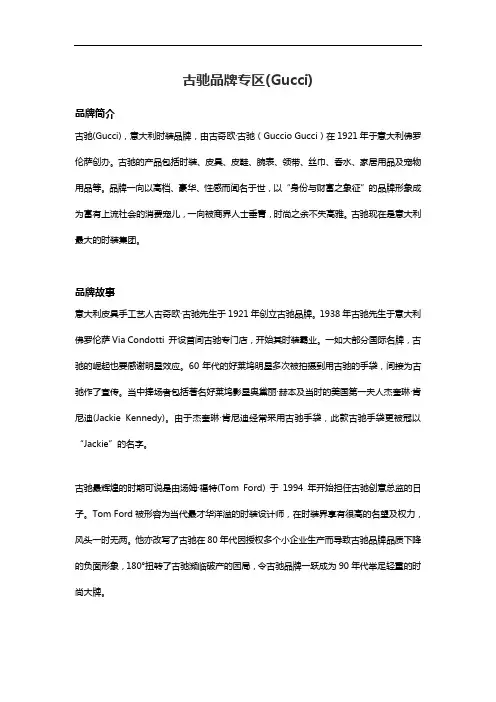
古驰品牌专区(Gucci)品牌简介古驰(Gucci),意大利时装品牌,由古奇欧·古驰(Guccio Gucci)在1921年于意大利佛罗伦萨创办。
古驰的产品包括时装、皮具、皮鞋、腕表、领带、丝巾、香水、家居用品及宠物用品等。
品牌一向以高档、豪华、性感而闻名于世,以“身份与财富之象征”的品牌形象成为富有上流社会的消费宠儿,一向被商界人士垂青,时尚之余不失高雅。
古驰现在是意大利最大的时装集团。
品牌故事意大利皮具手工艺人古奇欧·古驰先生于1921年创立古驰品牌。
1938年古驰先生于意大利佛罗伦萨Via Condotti 开设首间古驰专门店,开始其时装霸业。
一如大部分国际名牌,古驰的崛起也要感谢明星效应。
60年代的好莱坞明星多次被拍摄到用古驰的手袋,间接为古驰作了宣传。
当中捧场者包括著名好莱坞影星奥黛丽·赫本及当时的美国第一夫人杰奎琳·肯尼迪(Jackie Kennedy)。
由于杰奎琳·肯尼迪经常采用古驰手袋,此款古驰手袋更被冠以“Jackie”的名字。
古驰最辉煌的时期可说是由汤姆·福特(Tom Ford) 于1994年开始担任古驰创意总监的日子。
Tom Ford被形容为当代最才华洋溢的时装设计师,在时装界享有很高的名望及权力,风头一时无两。
他亦改写了古驰在80年代因授权多个小企业生产而导致古驰品牌品质下降的负面形象,180°扭转了古驰濒临破产的困局,令古驰品牌一跃成为90年代举足轻重的时尚大牌。
汤姆·福特创新地采用优质高科技面料设计古驰时装,领导了时装界对布料要求的新方向。
汤姆·福特在职期间曾多次引领时尚界潮流,令古驰与时尚划上等号。
如95年古驰秋冬时装秀,名模Kate Moss在T台上以一身古驰天鹅绒低腰裤及丝质衬衫,配衬粗黑眼线的look,迅速成为国际明星名人模仿的对象。
而汤姆·福特于2004年4月宣布离职的消息轰动了整个时装界,当时曾有人认为古驰皇朝从此结束。
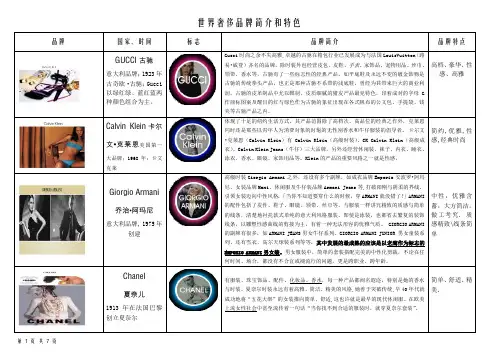
世界奢侈品牌简介和特色品牌国家、时间标志品牌简介品牌特点GUCCI古驰意大利品牌;1923年古奇欧·古驰;Gucci 以绿红绿、蓝红蓝两种颜色组合为主。
Gucci时尚之余不失高雅,卓越的古驰在箱包行业已发展成为与法国LouisVuitton(路易•威登)齐名的品牌。
除时装外也经营皮包、皮鞋、手表、家饰品、宠物用品、丝巾、领带、香水等,古驰有了一些标志性的经典产品,如平底鞋及永远不变的镀金饰物是古驰的传统拳头产品,也正是那种古驰不系带的浅底鞋,曾经为其带来巨大的商业利润。
古驰的皮革制品中尤以鞣制、皮质细腻的猪皮产品最见特色。
印着成对的字母G作商标图案及醒目的红与绿色作为古驰的象征出现在各式帆布的公文包、手提袋、钱夹等古驰产品之内。
高档、豪华、性感、高雅Calvin Klein卡尔文•克莱恩美国第一大品牌;1968年;卡文克莱体现了十足的纽约生活方式。
其产品范围除了高档次、高品位的经典之作外,克莱恩同时还是那些以青年人为消费对象的时髦的无性别香水和牛仔服装的倡导者。
卡尔文•克莱恩(Calvin Klein)有Calvin Klein(高级时装)、CK Calvin Klein(高级成衣)、Calvin Klein Jeans(牛仔)三大品牌,另外还经营休闲装、袜子、内衣、睡衣、泳衣、香水、眼镜、家饰用品等。
Klein的产品的重要风格之一就是性感,简约,优雅,性感,经典时尚Giorgio Armani乔治•阿玛尼意大利品牌, 1975年创建高级时装Giorgio Armani之外,还设有多个副牌,如成衣品牌Emporio安波罗•阿玛尼、女装品牌Mani、休闲服及牛仔装品牌Armani Jeans等,打破阳刚与阴柔的界线,引领女装迈向中性风格.「当你不知道要穿什么的时候,穿ARMANI就没错了!」ARMANI的配件包括了皮件、鞋子、眼镜、领带、丝巾等,与服装一样讲究精致的质感与简单的线条,清楚地衬托款式单纯的意大利风格服装。
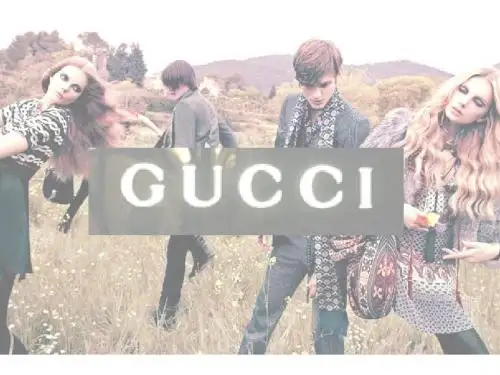
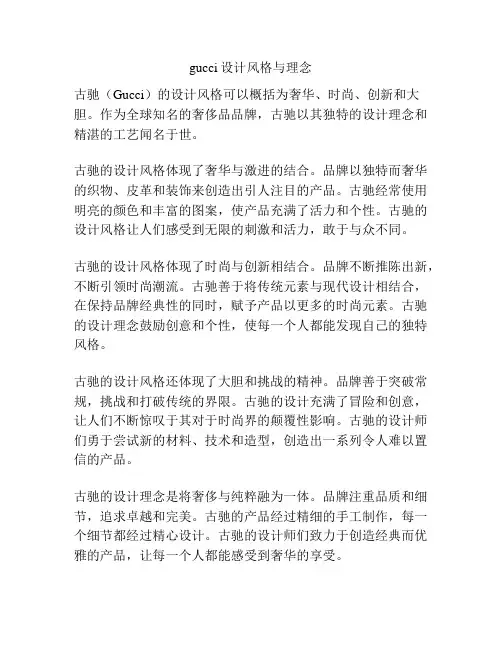
gucci设计风格与理念
古驰(Gucci)的设计风格可以概括为奢华、时尚、创新和大胆。
作为全球知名的奢侈品品牌,古驰以其独特的设计理念和精湛的工艺闻名于世。
古驰的设计风格体现了奢华与激进的结合。
品牌以独特而奢华的织物、皮革和装饰来创造出引人注目的产品。
古驰经常使用明亮的颜色和丰富的图案,使产品充满了活力和个性。
古驰的设计风格让人们感受到无限的刺激和活力,敢于与众不同。
古驰的设计风格体现了时尚与创新相结合。
品牌不断推陈出新,不断引领时尚潮流。
古驰善于将传统元素与现代设计相结合,在保持品牌经典性的同时,赋予产品以更多的时尚元素。
古驰的设计理念鼓励创意和个性,使每一个人都能发现自己的独特风格。
古驰的设计风格还体现了大胆和挑战的精神。
品牌善于突破常规,挑战和打破传统的界限。
古驰的设计充满了冒险和创意,让人们不断惊叹于其对于时尚界的颠覆性影响。
古驰的设计师们勇于尝试新的材料、技术和造型,创造出一系列令人难以置信的产品。
古驰的设计理念是将奢侈与纯粹融为一体。
品牌注重品质和细节,追求卓越和完美。
古驰的产品经过精细的手工制作,每一个细节都经过精心设计。
古驰的设计师们致力于创造经典而优雅的产品,让每一个人都能感受到奢华的享受。
总而言之,古驰的设计风格体现了奢华、时尚、创新和大胆。
品牌的设计理念鼓励创意和个性,突破常规,挑战和打破传统的界限。
古驰的产品以其精湛的工艺和卓越的品质赢得了众多粉丝的喜爱和认可。
古驰通过设计与时尚界的互动,不断引领时尚潮流,成为了全球奢侈品品牌的标志之一。
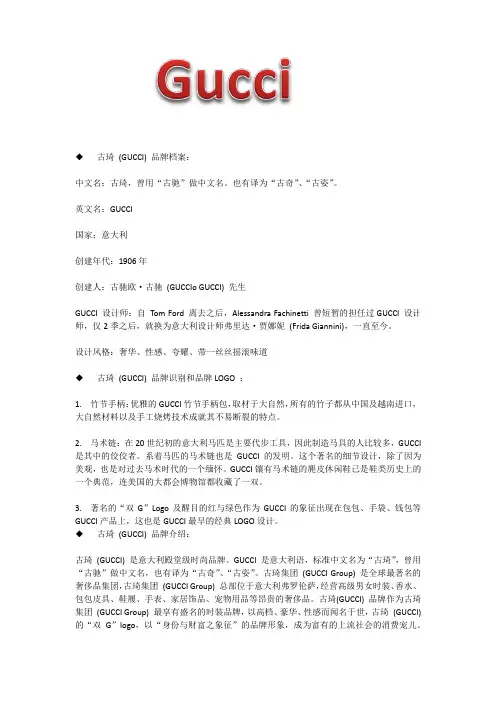
Gucci◆古琦(GUCCI) 品牌档案:中文名:古琦,曾用“古驰”做中文名。
也有译为“古奇”、“古姿”。
英文名:GUCCI国家:意大利创建年代:1906年创建人:古驰欧·古驰(GUCCIo GUCCI) 先生GUCCI 设计师:自Tom Ford 离去之后,Alessandra Fachinetti 曾短暂的担任过GUCCI 设计师,仅2季之后,就换为意大利设计师弗里达·贾娜妮(Frida Giannini),一直至今。
设计风格:奢华、性感、夸耀、带一丝丝摇滚味道◆古琦(GUCCI) 品牌识别和品牌LOGO :1. 竹节手柄:优雅的GUCCI竹节手柄包,取材于大自然,所有的竹子都从中国及越南进口,大自然材料以及手工烧烤技术成就其不易断裂的特点。
2. 马术链:在20世纪初的意大利马匹是主要代步工具,因此制造马具的人比较多,GUCCI 是其中的佼佼者。
系着马匹的马术链也是GUCCI的发明。
这个著名的细节设计,除了因为美观,也是对过去马术时代的一个缅怀。
GUCCI镶有马术链的麂皮休闲鞋已是鞋类历史上的一个典范,连美国的大都会博物馆都收藏了一双。
3. 著名的“双G”Logo及醒目的红与绿色作为GUCCI的象征出现在包包、手袋、钱包等GUCCI产品上,这也是GUCCI最早的经典LOGO设计。
◆古琦(GUCCI) 品牌介绍:古琦(GUCCI) 是意大利殿堂级时尚品牌。
GUCCI 是意大利语,标准中文名为“古琦”,曾用“古驰”做中文名,也有译为“古奇”、“古姿”。
古琦集团(GUCCI Group) 是全球最著名的奢侈品集团,古琦集团(GUCCI Group) 总部位于意大利弗罗伦萨,经营高级男女时装、香水、包包皮具、鞋履、手表、家居饰品、宠物用品等昂贵的奢侈品。
古琦(GUCCI) 品牌作为古琦集团(GUCCI Group) 最享有盛名的时装品牌,以高档、豪华、性感而闻名于世,古琦(GUCCI) 的“双G”logo,以“身份与财富之象征”的品牌形象,成为富有的上流社会的消费宠儿。

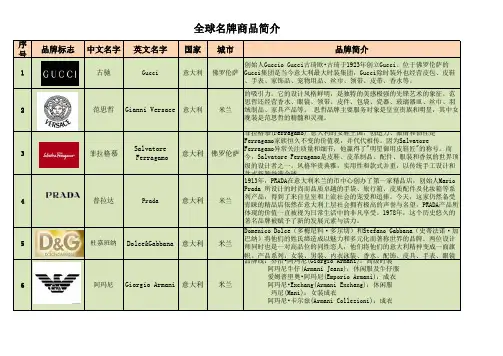
序号品牌标志中文名字英文名字国家城市品牌简介1古驰 Gucci 意大利佛罗伦萨创始人Guccio Gucci古琦欧•古琦于1923年创立Gucci。
位于佛罗伦萨的Gucci集团是当今意大利最大时装集团,Gucci除时装外也经营皮包、皮鞋、手表、家饰品、宠物用品、丝巾、领带、皮带、香水等。
2范思哲Gianni Versace 意大利米兰创立于1978年,品牌标志是神话中的蛇妖美杜莎(Medusa),代表着致命的吸引力。
它的设计风格鲜明,是独特的美感极强的先锋艺术的象征。
范思哲还经营香水、眼镜、领带、皮件、包袋、瓷器、玻璃器皿、丝巾、羽绒制品、家具产品等。
思哲品牌主要服务对象是皇室贵族和明星,其中女晚装是范思哲的精髓和灵魂。
3菲拉格慕SalvatoreFerragamo意大利佛罗伦萨菲拉格慕(Ferragamo) 意大利的女鞋王国,创造力、激情和韧性是Ferragamo家族恒久不变的价值观,并代代相传。
因为SalvatoreFerragamo异常关注质量和细节,他赢得了"明星御用皮鞋匠"的称号。
而今,Salvatore Ferragamo是皮鞋、皮革制品、配件、服装和香氛的世界顶级的设计者之一。
风格华贵典雅,实用性和款式并重,以传统手工设计和款式新颖誉满全球。
4普拉达 Prada意大利米兰1913年,PRADA在意大利米兰的市中心创办了第一家精品店,创始人Mario Prada 所设计的时尚而品质卓越的手袋、旅行箱、皮质配件及化妆箱等系列产品,得到了来自皇室和上流社会的宠爱和追捧。
今天,这家仍然备受青睐的精品店依然在意大利上层社会拥有极高的声誉与名望,PRADA产品所体现的价值一直被视为日常生活中的非凡享受。
1978年,这个历史悠久的著名品牌被赋予了新的发展元素与活力。
5杜嘉班纳Dolce&Gabbana意大利米兰Domenico Dolce(多梅尼科·多尔切)和Stefano Gabbana(史蒂法诺·加巴纳)将他们的姓氏缔造成以魅力和多元化而著称世界的品牌。
GUCCI(古琦)简介
·类型:高级成衣·创始人:古奇欧·古琦注册地:意大利佛罗伦萨(1923年)设计师:1923年-1989年,古奇欧·古琦1989年-1992年,Richardmbertson(理查德·兰伯森),时装设计兼创意指导1990年-1991年,DawnMello(唐·梅洛),美国籍设计师1994年,TomFord(汤姆·福特)
品牌线:Gucci古琦品类:服装、皮包皮鞋、手表、家饰品、宠物用品、丝巾与领带,1975年,成立古驰香水部,推出香水产品。
目标消费群:上层社会妇女,影星地址:73ViaTornabuoni,Florence,lTALY品牌传奇
自Karl Lagerfeld接管Chanel以来,最吸引人最令人震惊的要算是TomFord接手Gucci的故事了。
在1994年Tom Ford被任命为创意总监之前,Gucci家族已经由于经营管理不善而陷入困境濒临破产……
时尚必备:古琦尽管时装牌子令人眼花缭乱,GUCCI的风格却一向被商界人士垂青,时尚之余不失高雅,这个意大利牌子的服饰一直以简单设计为主,尤其是今季的男装,剪裁新颖,弥漫着十八世纪威尼期风情,再融入牛仔、太空和摇滚巨星的色彩,让豪迈中带点不羁,散发无穷魅力。
古琦(GUCCI)王国的当代传奇
在GUCCI的时尚王国中,有最受全球媒体宠爱、年轻又才华洋溢的设计师Tom Ford,更有包括麦当娜、玛莉亚凯莉、葛妮斯派特罗、伊丽莎白赫莉、布莱德彼特,还有汤姆汉克斯夫妇等阵容最坚强的影星死忠爱用者。
品牌故事范文品牌故事。
在这个竞争激烈的市场上,每个品牌都有自己独特的故事。
而今天我要向大家介绍的是一家来自意大利的奢侈品牌——Gucci。
Gucci的品牌故事不仅是一段传奇,更是一部奢华与传奇的结合,它的品牌故事不仅仅是一段历史,更是一段传奇。
Gucci的品牌故事始于1921年,当时的创始人古奇奥·古奇在意大利佛罗伦萨开设了一家皮具店。
古奇奥·古奇是一位技艺精湛的皮具工匠,他的手工艺精湛,深受顾客的喜爱。
不久,他的皮具店声名鹊起,成为了当地的名气之一。
然而,Gucci的品牌故事并不仅仅止于此。
在古奇奥·古奇的儿子阿尔多·古奇接手家族生意后,Gucci开始了快速的发展。
阿尔多·古奇将Gucci打造成了一个国际化的品牌,他将Gucci的产品线扩展到了服装、鞋子、手表、香水等多个领域,并且开始将Gucci的业务拓展到了国际市场。
在20世纪50年代,Gucci的品牌故事出现了一个转折点。
当时,Gucci的产品在好莱坞明星和国际名流中开始流行起来,成为了时尚界的宠儿。
而Gucci的品牌形象也因此得到了进一步的提升,成为了奢侈品界的代表之一。
然而,Gucci的品牌故事并不仅仅止于此。
在20世纪90年代,Gucci的品牌故事出现了一个新的转折点。
当时,Gucci的业务出现了一些问题,品牌形象也受到了一些负面的影响。
然而,正是在这个时候,Gucci找到了新的突破口。
他们邀请了时尚设计师汤姆·福特加入公司,汤姆·福特为Gucci注入了新的活力,他设计的产品不仅在市场上获得了极大的成功,更让Gucci的品牌形象焕发出了新的生机。
如今的Gucci已经成为了奢侈品界的领军品牌之一,它的品牌故事不仅仅是一段历史,更是一段传奇。
Gucci的产品不仅在市场上获得了巨大的成功,更成为了时尚界的标杆之一。
Gucci的品牌故事告诉我们,一个成功的品牌不仅需要有优质的产品,更需要有一个深厚的品牌故事。
世界十大顶级化妆品品牌介绍作者:孔淑红,霍亚丽看到一种说法,称化妆品行业是一个将希望装在瓶子里出售的行业。
不错,几乎每个女性都有一些瓶瓶罐罐,这些瓶瓶罐罐装的正是化妆品,给女性带来了自信和美丽,也给女性带来了希望,而当今,男性也逐渐加入到这个行列中来。
以前我们一提到化妆品,便不由自主的想到了女性化妆品,但是现在男士化妆品在全球范围内呈现迅猛增长的势头,国际大品牌纷纷推出自己的男士护肤用品来抢占市场,如欧莱雅集团(Biotherm)、妮维娅公司(Beiersdorf)等,均有不错的业绩表现。
随着男性对自身外表要求的提高,男士化妆品的市场前景和巨大的潜力已引起化妆品厂家的密切注意。
在欧美,男士护肤品的市场份额已达30%以上,使用专业男士护肤品早已是欧美男士的生活习惯和消费时尚。
不过在国内,目前男性化妆品尚未出现旺销态势,但拥有近亿成熟消费者的市场,可以说这是一个近在眼前的真实的待挖掘的市场。
化妆品行业的特点突出,总的来说,化妆品市场也很庞大,各类化妆品品种繁多,琳琅满目;销售层次多,高档、中档、低档都有许多产品,来迎合不同的消费层次的需求。
在销售方式上更是多种多样,专柜、专卖店、商场、商店、卖场、超市、电视、网络、直销、甚至药店。
随着人们生活水平不断提高,对化妆品的需求也不断增加,档次也不断提高。
从世界范围来看,当今世界的化妆品行业,虽然品牌众多,但是最吸引人眼球的莫过于四大化妆品帝国,下面介绍一下。
帝国之一:欧莱雅集团作为财富500强之一的欧莱雅集团,由发明世界上第一种合成染发剂的法国化学家欧仁舒莱尔创立于1907年。
历经近一个世纪的努力,今天,欧莱雅已从一个小型家庭企业跃居世界化妆品行业的领头羊。
欧莱雅集团是全球最大的化妆品集团,迄今为止,欧莱雅集团的事业遍及150多个国家和地区,在全球拥有42家工厂(其中三家在中国),每年生产的化妆品达40亿件。
在全球拥有283家分公司及100多个代理商,在全球还拥有50,491名员工、42家工厂和500多个优质品牌,目前,欧莱雅集团拥有巴黎欧莱雅、卡尼尔、兰蔻、赫莲娜、碧欧泉、植村秀、欧莱雅专业美发、卡诗、美奇丝、薇姿、理肤泉、美宝莲、SoftSheen-Carson、 Redken 、Kiehl’s、Giorgio Armani 和Ralph Lauren 等十七个国际知名优质品牌,涵括了从护肤、护发到彩妆、香水等众多领域,甚至卫浴及皮肤科专业药品也有涉及。
1. 为传承经典文化GUCCI推出手工制作展
“古驰(GUCCI)手工制作展示区”为最新推出之零售店活动,将GUCCI精湛的工艺从佛罗伦萨的皮革工厂带至身边的古驰(GUCCI)店面。
一年间,古驰(GUCCI)工匠们飞往世界各地,在各个精选店面中设立特制的工作间,展示GUCCI出色的工艺流程,现场制作并组装品牌最经典的各款手袋,包括Bamboo、New Jackie、New Pelham、以及G Wave。
透过这项活动,顾客得以深入了解古驰(GUCCI)值得骄傲的深厚品牌传统,并于现场亲眼见证工匠制作每一个古驰(GUCCI)皮革产品的卓越手工技艺:手工缝制手柄、组装竹节手柄、准备编织用的皮革条,以及手工压印顾客的姓名首字母缩写。
古驰(GUCCI)手工制作展示区2009 年以那不勒斯 (Naples) 作为首站,之后已巡回至全球各地,包括日本、美国与欧洲。
UCCI推出手工制作展
为庆祝巡回活动的开展,特别受邀的贵宾可至店内欣赏GUCCI产品从设计草图至成品的演变过程。
现场播放的独家珍贵资料视频,讲述着古驰(GUCCI)工匠多年来的工作点滴,尤其是经过历代家族传承的珍贵技艺。
2. 香艳玫瑰色Gucci2012早秋新款抢先看
近日,意大利著名奢侈品牌Gucci古奇析出品牌最新广告大片,大片画面以香艳的玫瑰色为主,Karmen Pedaru与Nadja Bender两位超模联袂演出,与男模Staffan Lindstrom亲密互动,让人遐想联翩。
Gucci 2012早秋系列
GUCCI 2012早秋系列广告大片,模特是Karmen Pedaru,Nadja Bender以及男模Staffan Lindstrom,由摄影师Mert & Marcus掌镜。
3. GUCCI 华丽中怀旧
在工业化生产和快速消费的今天,奢侈品更多地代表着一种生活态度,一种对品质的追求。
毋庸置疑,奢侈品属于暴利行业。
奢侈品保持旺盛的生命力其实有“章”可循——它们的隶属集团,无一例外地把产品设计师的地位摆到了品牌的前面。
这个头是由原Gucci的创作总监汤姆·福特开的——曾经当过模特、喜欢留平头的得州男子,于1990年加入Gucci。
喜欢玩创新的大男孩,不拘泥于品牌的固有设计风格,他主创的一系列以20世纪70年代为主题的设计,诸如MOD怀旧风潮、华丽的摇滚风格,让濒临破产的Gucci奇迹般地成为时尚界的宠儿。
他的创新之举都跟他平时习惯于收集亲朋好友的“情绪”有关。
注重小细节,顺应“民意”,适时而变的风格……成为Gucci新时代的标签。
当汤姆·福特从Gucci离职,继而去出任YSL创作总监的过程中,Gucci的主要股东法国巴黎春天的股价应声而落,而YSL的销售量却激增不少。
于奢侈品行业而言,任何拥有悠久历史渊源的品牌都像是枚徽标,而对消费者的需求了如指掌的设计师就像是朋友。
即便是寓意深刻的固体,但和鲜活的个体相比,后者的吸引力还是显得更大一些。
于是,当消费者不再忠于品牌的时候,品牌方还是希望他们能忠于某个具体的人——就像人们可以轻易抛弃一个徽标,但不会那么随意地抛弃一个朋友一般。
在行业走下坡路的时候,只要能保持消费者的忠诚度,无论什么方法都是可取的。
品牌之魂
在工业化生产和快速消费的今天,奢侈品更多地代表着一种生活态度,一种对品质的追求。
Chanel曾专门邀请与之合作的三大工坊来到中国内地,让消费者得以亲眼见证高级定制服装、鞋履,乃至用于品牌外包装袋的山茶花是怎样经由工匠的双手,通过诸多繁杂的步骤,才最终交予消费者手中。
4. Gucci 2012 Studded Lace-Up Oxford 绅士鞋款
意大利时尚精品大牌Gucci今季中推出了一款Studded Lace-Up Oxford 绅士鞋款。
意大利时尚精品大牌Gucci今季中推出了一款Studded Lace-Up Oxford 绅士鞋款,简约基本的样式,鞋面采全黑色光滑面皮革构成,而其中亮点部份即在于鞋面上的金色铆钉,还依照线条进行排列,衍生一番低调中的华丽美感,想要有成熟又不失独特性风格的男士们,此鞋款无疑是最佳首选,其定价为$880美金,现已于Gucci上架贩售。
5.神秘东方韵味GUCCI竹节包的经典符号
苏东坡一生酷爱竹子,须臾不可离之:“宁可食无肉,不可居无竹,无肉使人瘦,无竹使人俗。
”不知道在65前的意大利佛罗伦萨,Guccio Gucci先生是不是也受到中国文化的影响,感染到了东方人对
竹子的热烈推崇?
1947年,他大胆的决定在包袋的制作中使用竹子这种来自东方的新材料。
当时正值二战结束不久,战争结束了,但是战争造成的原料匮乏状态没有结束。
Guccio Gucci大胆启用“竹子”这种代表着东方风情的材质来替换金属,他从日本进口竹节,通过火烤加热使其软化并弯曲成一个独特的“u”的形状,然后通过金属环串联后与包身连接,竹节包这个设计史上经典就这样
出现了。
从设计角度来讲,皮质包身与竹子手柄,符合了“材料真实”和“形式追随功能”这两个在工艺美术运动中涌现出来的、被人们广泛接受的美学原则。
皮料与竹子,这样的材质配对既冲突又和谐,竹子手柄带来的异国情调,同时,同为天然材质的它们有种奇异的协调感——既实用又浪漫,竹节包一出现就广受欢迎。
在上世纪50年代与60年代,竹节皮包都很受欢迎,美艳的ElizabethTaylor、神秘的
IngridBergman,还有英国戏剧舞台戏骨级女演员VanessaRedgrave 都是竹节包的爱用者。
随着战后经济的复兴,意大利的工业化进程开始了,意大利设计品牌开始崛起,意大利从一个工业基地逐渐成为设计大国。
竹节也不再被拘泥于竹节包上,比如被用来装饰休闲的鞋面。
1971年,Gucci推出款竹节形状的银质手镯,竹节形状的金属质地皮带扣。
进入80年代之后,Gucci的雨伞使用竹节形状手柄,竹节被用来装饰钱夹。
1990年的Gucci女鞋则大胆地采用了竹子质地的鞋跟。
竹节这个细节被提炼出来,用不同的材质与方式表达出来。
比如成为图案,出现在头巾、包身、衣服面料之上;同时,手表的腕带、珠宝等等也用竹子之外的材质打造出竹节的形象。
半个多世纪之后,竹节不复当年的实用主义的初衷,成为Gucci的一个设计标志。
今天,Gucci的竹节包被奉为“意大利制作Made inItaly”的典范。
从1947年诞生之日到今日,“竹节” 从实用主义演变成设计历史上的经典符号,这和半个多世纪以来,Gucci 对“竹节”这个细节设计
的不断再设计不无关系。
如今,Gucci创作总监FridaGiannini,将品牌经典的竹节包注入她强烈的现
代设计灵感,重新演绎成为“NewBamboo”。
正如我们常说的那样,从历史中寻找灵感,用设计承传历
史,用新的方式表现熟悉的事物。
6. 一应俱全慢慢游 Gucci漫游伦敦系列新品
早前意大利奢侈品牌Gucci(微博)曾一口气推出多个城市的限定商品,之前的主题都是欧洲有名的度假城市,本次Gucci 特意以奥运会的东道主伦敦为主角,以旅行为主题推出了一双高筒系带鞋、手袋和tote-bag,完全满足你旅游观光的出
行需求。
Gucci漫游伦敦系列新品
无论是鞋款还是包包均选用了上等皮革制造,设计师特别以伦敦的黎明天际线为图案,加上对比度强烈的橘黄、嫩绿、枣红和靛蓝配件,五种取自奥运五环的色彩组成了最新的颜色混搭。
同时推出的还有一款Gucci City腕表和红白蓝三色太阳眼镜,全套系列将于数月内登陆各大Gucci零售商,各位不妨多多关注啦。
Gucci漫游伦敦系列新品
Gucci漫游伦敦系列新品手袋
Gucci漫游伦敦系列新品腕表
Gucci漫游伦敦系列新品墨镜
Gucci漫游伦敦系列新品ipad套。